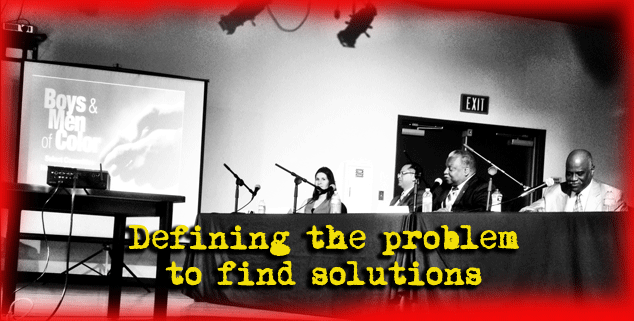After a year’s worth of packed regional hearings in Oakland, Los Angeles, Fresno and Coachella, the California State Assembly’s Select Committee on the Status of Boys and Men of Color returns to Sacramento on Wednesday, August 8, to issue a 50 plus-page report that describes all the ways that too many of California’s young men of color are not thriving—and what must be done about it, if California itself is to thrive.
The report’s findings deal with discouraging disparities in educational opportunities, in employment, in the disproportion of black and hispanic kids in the juvenile justice system…and more.
The report also has a list of policy and legislative recommendations
Thus far, members of the bi-partisan committee, headed by Assemblyman Sandré Swanson, have produced 19 bills that coincide with the committees findings, all of which are currently pending in the state legislature. Most have to do with correcting the policies of zero tolerance and punitive discipline in schools, which have been shown to do far more damage than good.
Harder to address will be some of the juvenile justice issues (which we’ll be covering over the next year).
Scott Johnson of the San Jose Mercury News has more on the report and its findings.
Here’s a clip:
In California, by a 36 to 27 percent ratio, young African-American men without a high school diploma or its equivalent are more likely to be found languishing in prison than working a regular job. Young Latino men are roughly 40 percent more likely than white men to wind up serving time in an adult prison. And African-American kindergartners are more than three times as likely as their white playmates to believe they lack the ability to succeed in school.
These are just some of the disturbing findings that will be brought to light in a report Wednesday when the California Assembly’s Select Committee on the Status of Boys and Men of Color presents its working action plan at its sixth and final hearing in Sacramento.
The report is part of a sweeping effort, the first of its kind in California, to accurately assess the myriad ways in which young men of color across the state are falling behind when it comes to success in school, access to health care, employment and a host of other critical public health, safety and criminal justice issues. The report also lays out a breathtaking array of policy suggestions, legislative proposals and ideas for ways policymakers can improve the health outcomes of the state’s most vulnerable and at-risk individuals.
Christiana Hoag of the AP has still more. Here’s a clip:
“Doing nothing is not an option,” said Sandre Swanson, the Oakland Democrat who heads the subcommittee. “Young men of color in trouble cost the state of California billions of dollars. There’s a moral question to be addressed here, too.”
The report, which was the culmination of a series of five hearings the subcommittee conducted around the state over the past year, termed the issue “a serious threat ” to California’s future success in light of statewide demographic trends.
An aging population, declining birth rates and growing number of minority residents will force California to increasingly rely on its young workforce as its economic mainstay, and about 71 percent of the state’s under-25 population comprises black, Latino, Asian, Native American and Pacific Islanders.
Males in those groups tend to fare worse than other population segments, “trapped in a cycle of prison, poverty, and disadvantage,”
The report said. “Deteriorated schools and neighborhoods, poor health, dysfunctional social support and limited job opportunities hamper their progress … improving opportunities for all young adults, particularly those of color, is a state imperative.'”
The final hearing on Wednesday will LIVE STREAM from 1pm to 4pm.
Photo by WitnessLA


“…the state’s under-25 population comprises black, Latino, Asian, Native American and Pacific Islanders.
Males in those groups tend to fare worse than other population segments….”
I have to applaud the Assembly Select Committee for delving into the issue, but——do the statistics agree with placing asians into the crisis demographic of this study?